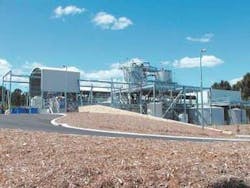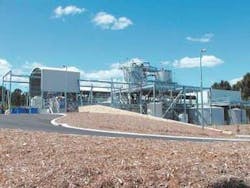DOC Removal System Enters US Market
Orica Watercare, in conjunction with two Australian research organizations (Commonwealth Scientific Industrial Research Organization's Division of Molecular Science and South Australian Water Corporation's Australian Water Quality Centre), have developed a process that incorporates the MIEX® DOC Resin for the removal of dissolved organic carbon and other anions from potable water sources.
Recently, Orica Watercare signed an agreement with WesTech Engineering Inc. for WesTech to manufacture and market water treatment systems using the resin.
Many water utilities face a number of challenges in treating their available water sources to meet the current
EPA water quality standards. These challenges will only increase as EPA tightens standards. For many utilities, conventional treatment processes will no longer be suitable.
Ion exchange has long been recognized as a technology capable of removing many compounds from water sources that cause water quality problems, but short-comings such as high capital costs and resin fouling have limited its use in large scale water treatment plants. A new magnetic ion exchange resin (MIEX) has been developed for use in a continuous ion exchange process that overcomes many of the problems associated with conventional ion exchange systems and makes this technology economically feasible for large water treatment plants.
The MIEX resin has been specifically designed for the removal of dissolved organic carbon (DOC) from drinking water supplies. The negatively charged DOC is removed from water by exchanging with a chloride ion on active sites on the resin surface. Unlike conventional ion exchange processes, the MIEX resin is designed to remove DOC in a stirred contactor, much like a flash mixer in a conventional water treatment plant. Under mixing conditions, the resin beads are uniformly dispersed in water to maximize the kinetics of DOC exchange. This reduces the resin inventory in contact with water to only 2-12 percent of that normally associated with conventional ion exchange processes.
A magnetic component is built into the resin particle structure so that when mixing is removed, the fine resin beads rapidly agglomerate into larger, fast settling particles. This enables conventional up-flow settlers to be used for resin-water separation. While the treated water overflows from the settler, the resin is recovered as a concentrated underflow stream. The efficiency of resin recovery exceeds 99.9 percent at very high settler rise rates (4 gpm/ft2).
By removing DOC, the MIEX® treatment systems can help reduce disinfection by-products (THMs and HAAs) and reduce chlorine demand for disinfection. The system also reduces coagulant doses and chemical sludge volumes. A reduction in color is typically seen, and the process removes other anions (i.e. sulfide, sulfate, bromide, arsenic). It is a flexible treatment process that can be used to treat raw water at the start of the treatment chain, or as a polishing step at the end.
The first stage of the world's largest MIEX® treatment process (30 mgd) was commissioned in Perth, Western Australia, in 2001 to pre-treat the raw water supply to the Wanneroo Ground Water Treatment Plant. In the past year, several trials have been conducted within the United States, demonstrating removal of DBP precursors and the applicability of the technology for achieving the EPA Stage 1 and 2 DBP Rules.

